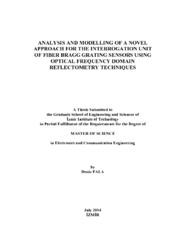Please use this identifier to cite or link to this item:
https://hdl.handle.net/11147/4191Full metadata record
| DC Field | Value | Language |
|---|---|---|
| dc.contributor.advisor | Yüksel Aldoğan, Kıvılcım | - |
| dc.contributor.author | Pala, Deniz | - |
| dc.date.accessioned | 2014-11-19T08:42:10Z | |
| dc.date.available | 2014-11-19T08:42:10Z | |
| dc.date.issued | 2014 | - |
| dc.identifier.uri | http://hdl.handle.net/11147/4191 | - |
| dc.description | Thesis (Master)--Izmir Institute of Technology, Electronics and Communication Engineering, Izmir, 2014 | en_US |
| dc.description | Includes bibliographical references (leaves: 83-87) | en_US |
| dc.description | Text in English; Abstract: Turkish and English | en_US |
| dc.description | xii, 95 leaves | en_US |
| dc.description.abstract | The main purpose of this thesis is to demonstrate the feasibility of using polarization properties of FBGs interrogated by OFDR for quasi-distributed sensing applications. A fiber Bragg grating (FBG) is a constant and periodic refractive index value modulation within the core along an optical fiber. This modification is generally obtained by exposing the fiber core of a photosensitive optical fiber to an intense ultraviolet (UV) interference pattern. At the fabrication process of Bragg gratings, only one side of the fiber expose to UV light. As a result, refractive index change is not constant at the cross section of fiber. This non-uniformity on the refractive index gives rise to photo-induced birefringence which combines with the birefringence resulting from the slightly elliptical shape of the optical fiber and creates a global birefringence value. In the presence of the birefringence, the reflection (transmission) spectrum of Bragg grating is degenerated into two reflection (transmission) spectra corresponding to a pair of orthogonal polarization modes (x and y modes). The ratio between maximum and minimum optical transmitted power of these modes are defined as Polarization Dependent Loss (PDL). We analyzed the reflection spectrum, transmission spectrum and the PDL of the cascaded FBGs interrogated by an OFDR by the way of simulations. Based on the simulation results, we demonstrated the feasibility of a novel FBG interrogation method which can be implemented in quasi-distributed strain sensors embedded into composite materials. | en_US |
| dc.language.iso | en | en_US |
| dc.publisher | Izmir Institute of Technology | en_US |
| dc.rights | info:eu-repo/semantics/openAccess | en_US |
| dc.subject | Fiber optics | en_US |
| dc.subject | Optical sensors | en_US |
| dc.title | Analysis and Modelling of a Novel Approach for the Interrogation Unit of Fiber Bragg Grating Sensors Using Optical Frequency Domain Reflectometry Techniques | en_US |
| dc.title.alternative | Frekans Bölgesinde Optik Yansıma Ölçüm Teknikleri Kullanılarak Fiber Bragg Izgara Sensörlerinin Sorgu Ünitesi için Yeni Bir Yaklaşımın Analiz ve Modellenmesi | en_US |
| dc.type | Master Thesis | en_US |
| dc.authorid | TR116981 | - |
| dc.institutionauthor | Pala, Deniz | - |
| dc.department | Thesis (Master)--İzmir Institute of Technology, Electrical and Electronics Engineering | en_US |
| dc.relation.publicationcategory | Tez | en_US |
| dc.identifier.wosquality | N/A | - |
| dc.identifier.scopusquality | N/A | - |
| item.openairecristype | http://purl.org/coar/resource_type/c_18cf | - |
| item.languageiso639-1 | en | - |
| item.openairetype | Master Thesis | - |
| item.grantfulltext | open | - |
| item.fulltext | With Fulltext | - |
| item.cerifentitytype | Publications | - |
| Appears in Collections: | Master Degree / Yüksek Lisans Tezleri | |
Files in This Item:
| File | Description | Size | Format | |
|---|---|---|---|---|
| 10044846.pdf | MasterThesis | 1.59 MB | Adobe PDF |  View/Open |
CORE Recommender
Sorry the service is unavailable at the moment. Please try again later.
Items in GCRIS Repository are protected by copyright, with all rights reserved, unless otherwise indicated.